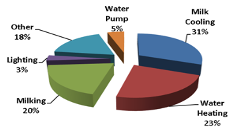Farm Energy Efficiency
Energy usage on farms accounts for a small percentage of overall costs but a saving in this area will have a direct impact on the profitability and competitiveness of the business especially in the current climate where energy costs have soared within the last year.
Increased energy efficiency within the farm and current infrastructure is a good place to start making savings.
Energy Costs
There can be a huge variation in energy costs across farms. Electricity costs alone can vary from €2.50 - €9.00 per 1,000 litres or €15 - €50 per cow per year. The average cost is €5.00 per 1,000 litres. This huge variation can be down to a number of factors for instance the type of fuel used or using high cost day rate electricity. Dairy farms three main energy intensive processes are milk cooling (31%), water heating (23%) and the milking process (20%) which can be seen in the chart to the right with a further breakdown of the other energy consumption areas.

Energy Efficiency
The initial phase of the process to improve efficiency is to identify the key users of electricity throughout the farm. The consumption of power used and relative costs can be collated through the collecting and analysing of bills, reading meters often or having a smart meter installed if not already present. Several more basic measures that can be adopted are having sufficient lagging on heating and cooling systems, using timer switches, having equipment well maintained, using LED lighting and ensuring that you are getting best rate possible from the supplier by using a comparison website and maximising off peak rates with night rate roughly half the cost of day rate electricity.
Milk Cooling
- Pre cooling milk using a plate cooler can reduce cooling costs by up to 40%. Water: Milk ratio should be 2:1 with the goal to reducing milk temperature to within 5˚C of the entering water temperature.
- The installation of a plate cooler can give a saving of up €1000 a year and a possible payback period of 3 years.
- The use of a variable speed milk pump in conjunction with the plate cooler and in line solenoid to reduce water wastage will increase cooling efficiency further.
- The water post plate cooler should be stored for washing the plant and or equipment.
Heat Recovery
- Heat from cooling milk in the bulk tank is usually released into the air by the condenser of the refrigeration unit.
- The heat recovery unit transfers energy from the refrigerant to water in a storage tank, raising the water temperature.
- 40 – 50 % cost reduction on water heating.
- These systems can be easily retro fitted and is one of the most efficient ways to save energy on dairy farms.
Variable Speed Vacuum Pump
- The speed of the pump fluctuates in line with the need for vacuum throughout the milking process.
- Savings up to 60% possible over standard vacuum pumps.
Water Heating
- Electricity is most popular for farms using up to 300L/day as it gives the best balance of capital and running costs. These units should have timers installed for night rate use. Long heating times and night rate use can sometimes make it restrictive. A water softener may be needed if water is hard as a build-up of lime scale can reduce the efficiency of the heater by up to 25%.
- The thermostat should be checked regularly to ensure optimum temperatures.
- Water heaters should have good insulation, losses of less than 5% on well insulated heaters can be achieved compared with up to 50% from water stored in a bare cylinder.
- Water leaks should be minimised as a hot water leak of a drip every second could cost up to 400/year.
Solar Energy
Solar PV (photovoltaic) is the most cost efficient system to supply renewable energy on farm as it generates renewable electricity from the sun which is a valuable method of replacing fossil fuels and in turn reducing energy costs. A 6kW PV system which would be typical of a 100 cow herd installation would have an outcome of 30% of the farms electricity being supplied by a renewable source which in turn could offset up to 2.4 tonnes of CO2/year. Solar PV systems can divert excess energy to heat water, effectively using the water tank as a battery storing the hot water to be used when needed. These systems are often eligible for grant aid therefore when looking at these systems all finance options should be explored. Glanbia have teamed up with SSE Airtricity and Activ8 Solar Energies to bring you the FarmGen Solar Powered Bundle which is suitable for all farming sectors and sizes, with bespoke packages available on request. There are also options available for Glanbia Ireland customers who wish to install Solar PV in their homes to harness the power of green energy. Glanbia Ireland farmers who wish to register their interest for this product can phone: 1890-928-889 or visit: www.farmgen.ie.
Decision Time
The payback period and type of systems that can or should be used on farms is heavily dependent on a case by case bases as factors such as herd size, farmer age, water supply, milking system and if grant aid eligible all need to be taken into account. Research has identified potential to reduce energy related CO2 emissions from dairy production by 40% through adopting energy efficient technologies as discussed above and a further 20% reductions are possible through adoption of renewables. The table below compiled by Teagasc research shows a rough guide to costs, annual savings and payback times on a range of systems that can make your farm more energy and cost efficient. The Dairy Energy Decision Support Tool (DEDST) is a free online tool developed so businesses can gain specific recommendations related to energy use investments in technology, CO2 mitigation and renewable energy. Farm specific details can be entered and feedback of the payback period, carbon emissions reduction and cost efficiency of investments are all relayed back in a simple format. DEDST can be accessed via the following link at https://messo.cit.ie/dairy

For further information please contact your local Glanbia Ireland representative.
First Published 20 December 2021
Tagged with: Dairy
